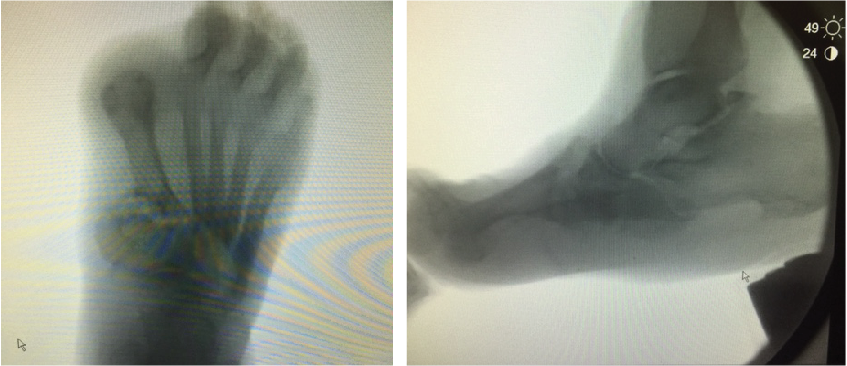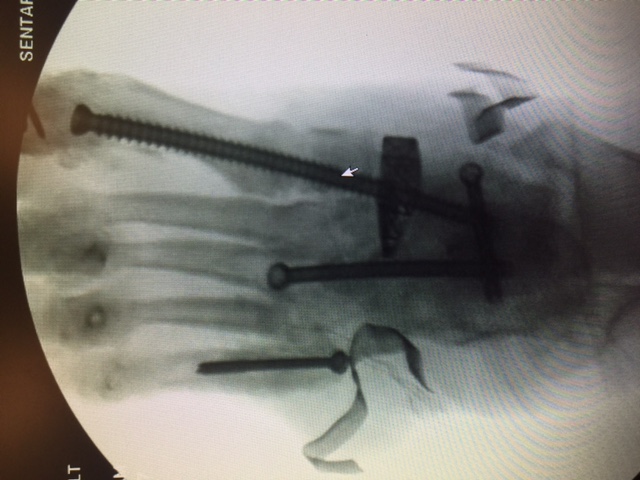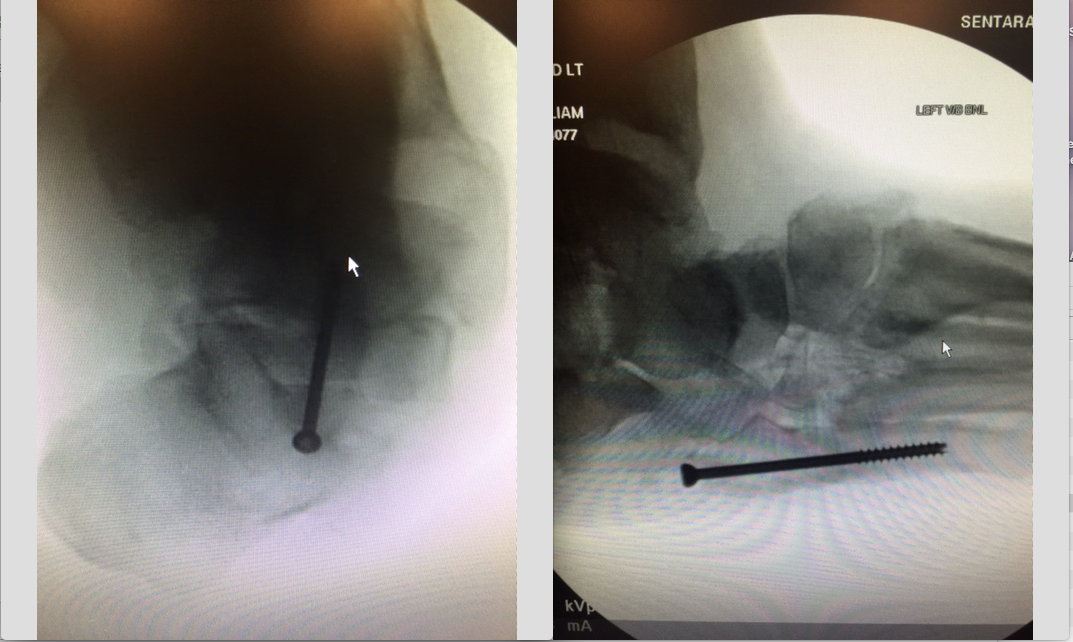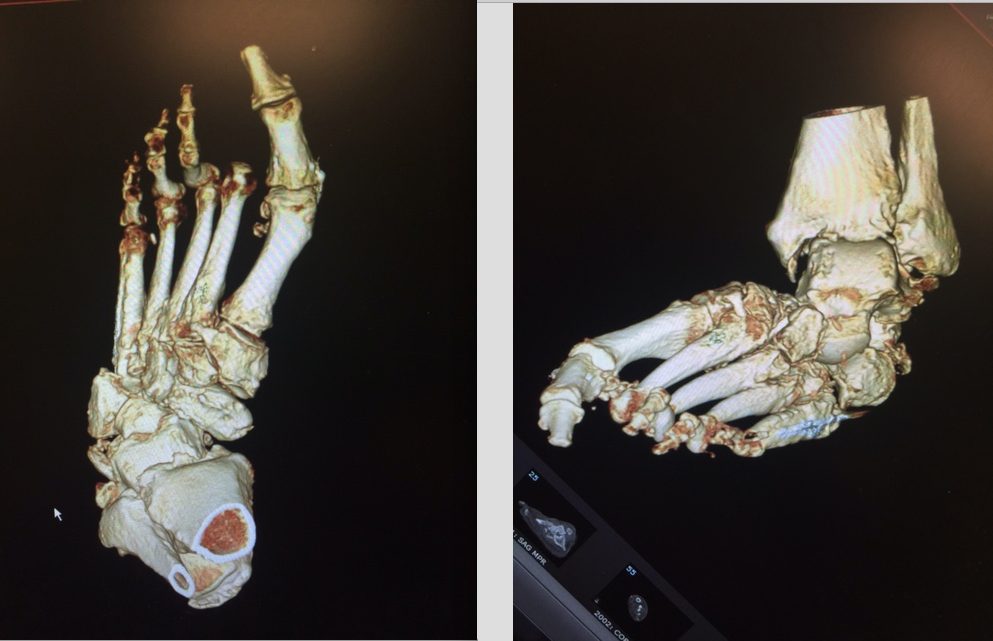ADVERTISEMENT
Emerging Concepts In Beaming For Charcot
Midfoot beaming for patients with Charcot can be a valuable tool for deformity correction and may help obviate complications that can hamper healing. These authors detail their experience with the use of beaming, focusing on effective correction techniques and innovative concepts such as titanium trusses.
 Surgical reconstruction of the Charcot foot utilizes a vast array of principles that may not parallel those of surgery in a healthier subset of patients. It is well recognized that patients with neuroarthropic bone suffer with significant comorbidities that complicate surgical healing (bone and soft tissue). Midfoot beaming has emerged as a method to mitigate the complications associated with Charcot healing and is specific for the needs of a compromised host.
Surgical reconstruction of the Charcot foot utilizes a vast array of principles that may not parallel those of surgery in a healthier subset of patients. It is well recognized that patients with neuroarthropic bone suffer with significant comorbidities that complicate surgical healing (bone and soft tissue). Midfoot beaming has emerged as a method to mitigate the complications associated with Charcot healing and is specific for the needs of a compromised host.
The limited soft tissue dissection and load sharing capabilities of beam screws are tailored for the biologic and biomechanical demands of the patient with Charcot.1 Grant and colleagues reviewed radiographic changes and outcomes for patients who had Charcot foot reconstruction over a 14-year period. In this study, surgeons performed beaming on 71 Charcot foot deformities in 70 patients. Twenty-two of the deformities were an isolated hindfoot deformity, 20 were an isolated Lisfranc deformity and 29 were a combination of hindfoot and Lisfranc deformities.
Reconstructive surgery for one group in the study involved only medial and lateral column beams.1 For another group in the study, surgery involved reconstruction with medial and lateral column beams in combination with either a subtalar arthroereisis or subtalar joint fusion. Both groups showed significant improvements in radiographic alignment, including Meary’s angle, the tarsometatarsal angle, the talonavicular angle and the calcaneocuboid angle. The study authors noted that the group that only had medial and lateral column beams also demonstrated a significant improvement in the calcaneal inclination angle whereas the second group did not. In both groups, authors note the surgical intervention maintained the correction and was useful for Charcot reconstruction.
 With regard to emerging concepts of midfoot beaming, improvement of deformity correction and positioning of the Charcot foot are primary concerns of our institution. Positioning of the Charcot foot for the acceptance of beam screws can be challenging and requires advanced deformity correction to reestablish normal pedal architecture. Often, Charcot collapse leads to severe malalignment of the foot that only large osseous resections can achieve appropriate alignment. This can inhibit the use of a true “superconstruct” as only limited healthy bone remains past the zone of deformity.2
With regard to emerging concepts of midfoot beaming, improvement of deformity correction and positioning of the Charcot foot are primary concerns of our institution. Positioning of the Charcot foot for the acceptance of beam screws can be challenging and requires advanced deformity correction to reestablish normal pedal architecture. Often, Charcot collapse leads to severe malalignment of the foot that only large osseous resections can achieve appropriate alignment. This can inhibit the use of a true “superconstruct” as only limited healthy bone remains past the zone of deformity.2
One should use midfoot osteotomies judiciously within the context of Charcot reconstruction. Given the wide variation of the Charcot collapse pattern, surgeons should plan surgical reconstruction and osteotomies based upon the pathoanatomy and biomechanics of the individual. Since Charcot joint collapse is unpredictable with regard to the forefoot, midfoot and hindfoot position, a combination of deformity correction is required to regain medial column alignment.
The most recognizable multiplanar deformity we have noted within this population is the pronated midtarsal joint. This is characterized by a loss of the medial longitudinal arch, abduction and possible supination of the forefoot. Bones of the lateral column are often superimposed with extrusion of the cuboid plantarly. Dislocation or fracture of the midfoot can occur at any of the midtarsal joints, producing a large bony mass medially. This deformity, although difficult to reduce, is often very amenable to a medial-based, truncated wedging.
 The varus midtarsal joint deformity is a particularly unique presentation with its own challenges. On an AP radiograph, there may be near superimposition of the talus and calcaneus. The mechanism may include overpowering of the tibialis posterior tendon with lateral column defects in alignment of the cuboid and peroneal tendon dysfunction. There is simultaneous collapse of the medial column with an abnormal Meary’s angle as well. Treatment should include release of the tibialis posterior tendon and reestablishment of the Meary’s angle with medial beaming and joint preparation of all joint surfaces.
The varus midtarsal joint deformity is a particularly unique presentation with its own challenges. On an AP radiograph, there may be near superimposition of the talus and calcaneus. The mechanism may include overpowering of the tibialis posterior tendon with lateral column defects in alignment of the cuboid and peroneal tendon dysfunction. There is simultaneous collapse of the medial column with an abnormal Meary’s angle as well. Treatment should include release of the tibialis posterior tendon and reestablishment of the Meary’s angle with medial beaming and joint preparation of all joint surfaces.
Practical Pointers On Placing Beam Screws
Placing beam screws with residual deformity can be challenging as the screw may not purchase healthy or substantial bone. For this reason, choosing the appropriate osteotomy is paramount. In instances of valgus collapse, physicians often utilize a medial-based wedge to correct the multiplanar deformity.
There is limited information in the literature regarding placement or the size of the wedge. Authors have suggested that the purpose of this wedge is to reestablish the “triangle of support” and reconstitute the medial longitudinal arch.3 Cotton theorized this would in turn restore the mechanics of weightbearing.
 Removal of malaligned “diseased bone” allows for transverse and sagittal correction of an abducted and supinated forefoot. Utilizing the truss theory of static medial column stabilization, we recognize that a truncated wedge shortens and translates the foot into a more mechanically neutralized position.
Removal of malaligned “diseased bone” allows for transverse and sagittal correction of an abducted and supinated forefoot. Utilizing the truss theory of static medial column stabilization, we recognize that a truncated wedge shortens and translates the foot into a more mechanically neutralized position.
The ultimate goal of reconstruction is to create an osteotomy, which reestablishes an anatomic Meary’s angle on A/P and lateral views, and allows for the application of beam screws. We caution against the rote use of medial-based wedges. These wedges have limited indications and they may accentuate deformity in patients who have been selected inappropriately. Results from our institution indicate that medial-based wedges in patients with even small degrees of hindfoot varus produced significant accentuation of hindfoot varus.4 Forefoot to hindfoot position is critical when preparing for medial column fusion as any misalignment will make it difficult to enter the talus with your fixation.
In patients with obvious varus deformity, a lateral-based wedge or excision of the cuboid can reduce the deformity. In these cases, an element of stacking is often visible and surgeons must address it. In situations of a subtle hindfoot varus or valgus, utilize a translational osteotomy to realign the Meary’s angle and not accentuate the hindfoot position. We find that wedge osteotomy is insufficient and one can readily enhance it through the additional maneuver of cutting a through and through osteotomy, and rotating the forefoot on the hindfoot. Lateral fluoroscopy will show where to rotate as the “stacking” resolves. We have found that often patients who have had translational osteotomies benefit from repositioning of the subtalar joint.
 Key Insights On The Effective Angles Of Correction
Key Insights On The Effective Angles Of Correction
In agreement with the works of Hentges and colleagues, we find that realignment of the subtalar joint demonstrates a significant effect on the talo-first metatarsal angle in both A/P and lateral projection.5 In the retrospective study, Hentges and coworkers reviewed the data from 16 patients (19 feet) who had a realignment subtalar joint arthrodesis. The study found statistically significant improvement in the A/P talo-first metatarsal angle, the lateral talo-first metatarsal angle, the tibial-calcaneal angle and tibial-calcaneal distance. The researchers also found a positive correlation between the tibial-calcaneal angle and tibial-calcaneal distance.
Hentges and colleagues concluded that proper realignment of the calcaneus to vertical and central under the tibia will facilitate the short-term success and perhaps long-term success of subtalar joint arthrodesis.5
In cases of hindfoot malalignment, we often perform additional osteotomy resections of the subtalar joint, which appears to facilitate appropriate reestablishment of the talo-first metatarsal angle.
Researchers have cited the reduction of Meary’s angle as the most significant reconstruction principle.1,6 In fact, our team has found that the overcorrection of Meary’s angle produces the best 10-year survivability.7
 Unpublished research from our institution also suggests that placing a screw across the subtalar joint produces better long-term survivability. This makes sense to our team from the perspective of bending moments across the arch of the foot. The more beams one adds to a static medial column system, the more beams share the load. Therefore, placing a beam through the second metatarsal, into the lesser tarsus and into the talar neck shares the load of the medial column of the foot.
Unpublished research from our institution also suggests that placing a screw across the subtalar joint produces better long-term survivability. This makes sense to our team from the perspective of bending moments across the arch of the foot. The more beams one adds to a static medial column system, the more beams share the load. Therefore, placing a beam through the second metatarsal, into the lesser tarsus and into the talar neck shares the load of the medial column of the foot.
Can Titanium Trusses Have An Impact?
Additional emerging concepts with regard to beaming within our institution include the use of titanium trusses for cases involving significant midfoot bone loss. We have performed several of these reconstructions with good long-term limb salvage results. Structurally speaking, titanium trusses accept and resist the same loads as beams. A benefit of a truss is the bending stiffness and bending strength is a factor of 4 or above the structural mass required for the midfoot, which can easily resist failure.
 In our experience, the mechanical forces of the midfoot in compression are enough to place the wedge without the need for fixation. However, we have routinely delivered beam screws through the titanium cage. We believe the truss acts as an additional load-bearing device with an independent section modulus that substitutes for the midfoot bone. When working in combination with a beam, we believe that the truss deflects forces from the beam.
In our experience, the mechanical forces of the midfoot in compression are enough to place the wedge without the need for fixation. However, we have routinely delivered beam screws through the titanium cage. We believe the truss acts as an additional load-bearing device with an independent section modulus that substitutes for the midfoot bone. When working in combination with a beam, we believe that the truss deflects forces from the beam.
Additionally, the titanium truss is filled with autogenous bone graft and orthobiologics, allowing for incorporation through the osteotomy site. This device allows for reconstruction in situations of excessive bone loss, acting as a replacement with the capacity for ingrowth. Follow-up demonstrates improved angular deformity correction with complete bridging on computed tomography (CT) scan.
In 2009, Sammarco and Chevillet described the concept of superconstructs for the treatment of Charcot foot deformity.2 Their goals included a stable, plantigrade, functional foot; resistance to ulcers; the prevention of amputation; improvement in the ability to perform daily activities; and the ability to wear non-prescription footwear. Their recommendations include the following four salient points.
1) Fusion should extend beyond the zone of injury to include joints that are not affected by Charcot.
2) Use the strongest device that patients can tolerate.
3) Apply the devices in a novel position that maximizes mechanical function. Use the strongest devices that the soft tissue can tolerate.
4) Perform bone resection to shorten the extremity to allow adequate reduction of the deformity without undue tension on the soft tissue envelope.
Within these aforementioned confines, we believe the use of beam screws with titanium truss wedges can be an additional superconstruct that surgeons can add to their arsenal.
Dr. Grant-McDonald is a third-year resident at Western Pennsylvania Hospital in Pittsburgh.
Dr. Grant is a Fellow of the American College of Foot and Ankle Surgeons, and is board-certified by the American Board of Podiatric Surgery. He is an instructor in the Department of Surgery at Eastern Virginia Medical School and is in private practice in Virginia Beach, Va.
Mr. Yates is an applicant to Virginia Tech Medical School.
References
- Grant WP, Garcia-Lavin S, Sabo R. Beaming the columns for Charcot diabetic foot reconstruction: a retrospective analysis. J Foot Ankle Surg. 2011; 50(2):182-189.
- Sammarco VJ, Chevillet J. The role of internal fixation in surgery of the Charcot foot and the evolution of “super-construct” techniques. Curr Orthoped Practice. 2010; 21(3):233-239.
- Cotton FJ. Foot statistics and surgery. N Engl J Med. 1936; 214(8):353-362.
- Grant LM, Catanzariti AR, Grant WP. Exaggerated hindfoot mal-alignment following midfoot Charcot reconstruction: a preliminary retrospective analysis. Presented at the American College of Foot and Ankle Surgeons Annual Scientific Meeting, Austin, TX, 2016.
- Hentges MJ, Gesheff MG, Lamm BM. Realignment subtalar joint arthrodesis. J Foot Ankle Surg. 2016; 55(1):16-21.
- Bevan WPC, Tomlinson MPW. Radiographic measures as a predictor of ulcer formation in diabetic Charcot midfoot. Foot Ankle Int. 2008; 29(6):568-573.
- Grant LM, Catanzariti AR, Grant WP. Long-term outcomes of Charcot reconstruction: a 20-year follow-up study. Presented at the American College of Foot and Ankle Surgeons Annual Scientific Meeting, Las Vegas, NV, 2017.
- Lapidus PW. Kinesiology and mechanical anatomy of the tarsal joints. Clin Orthop Rel Res. 1963; 30:20-36.
For further reading, see “A Closer Look At Beaming The Columns In The Charcot Diabetic Foot” in the March 2014 issue of Podiatry Today, “Do Superconstructs Offer More Biomechanically Sound Fixation Principles For Charcot?” in the January 2016 issue or “When Charcot Reconstructions Fail” in the December 2013 issue.











